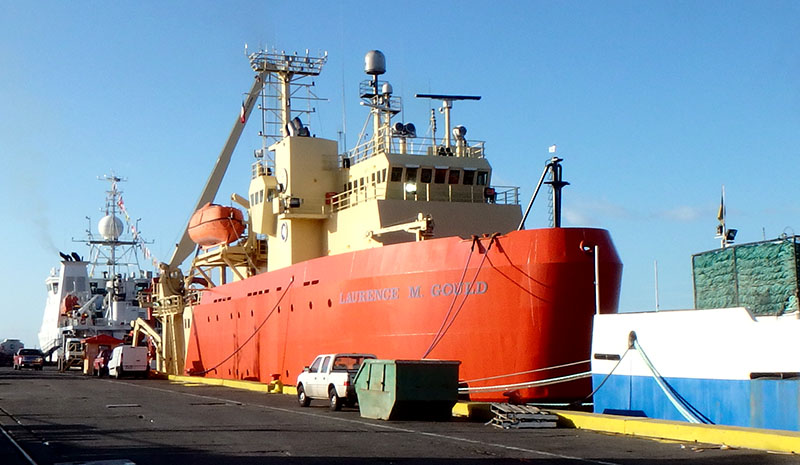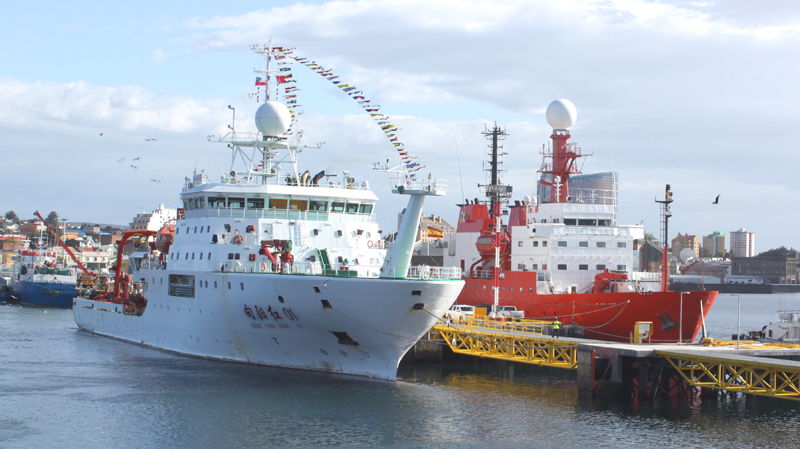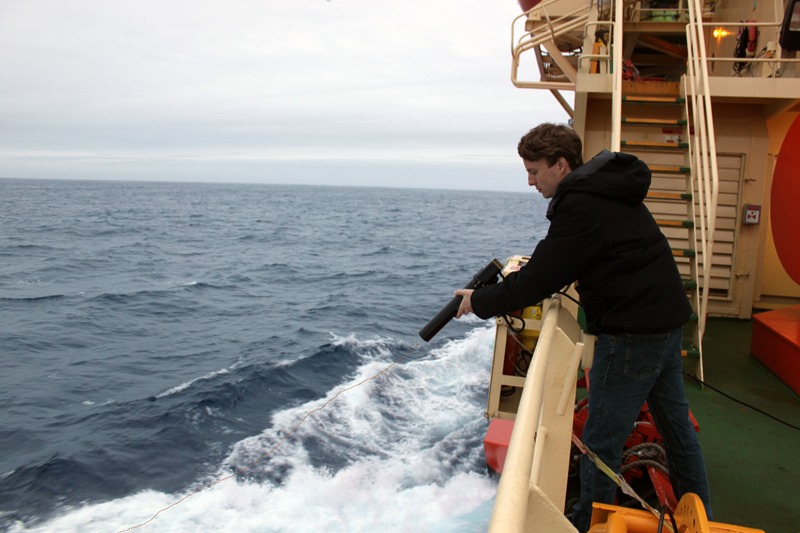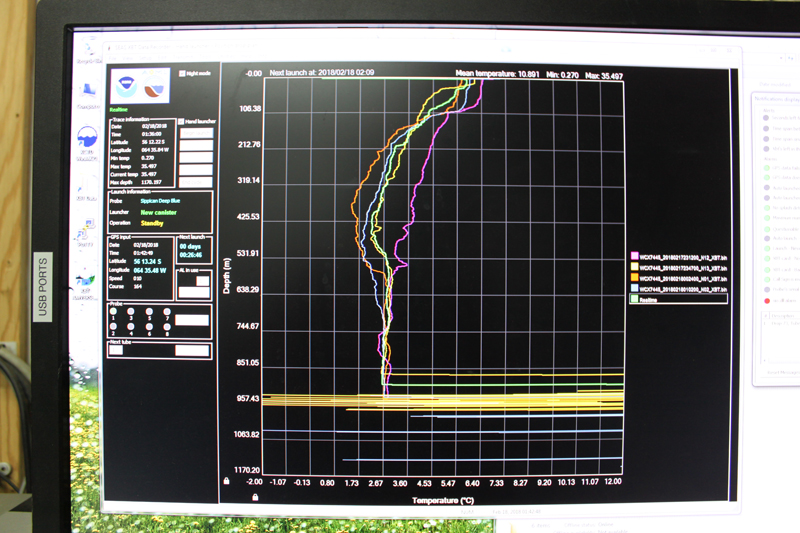
Sailing Day arrives in Punta Arenas, Chile with blue skies and fair winds!! The ARSV Laurence M. Gould (LMG) seemed to glow in the drenching early morning sunlight.
Our short time in Punta Arenas was busy. After the long three segments of air travel, including an overnight flight between Dallas and Santiago, Chile, horizontal sleep in a hotel bed was most welcome. The next day’s schedule was packed – breakfast, a scheduled brief medical check at 9 am, outfitting with our issued polar expedition gear, last minute souvenir or necessities shopping, hotel check out, and a quick lunch before the 2 pm orientation meeting on the ship. Immediately afterwards all hands were asked to assist with onload of ship supplies.
Normally, ship cargo is put on pallets and hoist in bulk onto the ship with strong cranes. However, refueling of the LMG was behind schedule and the crane could not operate during the process. Some 15 fuel trucks in total were on tap to sidle up to the ship throughout the day draining their liquid load into the Gould’s cavernous tanks.
Meanwhile, truckloads of other gear had to be transferred onto the ship. Without use of the crane it was all hands on deck. First came the “freshies” truck laden with fruit, vegetables, milk, eggs, butter and yogurt. Chuck was selected as quality control inspector and in scrutiny did turn away some poor quality salad greens. After meriting a seal of approval, each freshie box was passed down a line of people snaking from the truck on the pier, up the gangway, and across the ship’s main deck before disappearing into ship storage. During lulls of lengthier inspections the ‘hands’ amused themselves by playing a game of telephone. The silly message did indeed change with passage down the line.
The arrival of another truck meant no more lulls in activity as bags of issued expedition gear, personal luggage, science cargo, even propane tanks and water jugs for a geology field camp, were interspersed between boxes of watermelon, cabbage, etc. The line of hands on deck bifurcated as the non-food items were shuttled forward (toward ship’s bow) and the freshies continued aft. “Many hands make lighter work“ yet it still took 30 some people about an hour and a half to move and stow all the goods. The activity was most emblematic of Antarctica’s cooperative spirit.

The dock at Punta Arenas during our brief stay was like a mini United Nations. Not only were Chilean and Korean fishing vessels tied alongside but other Antarctic research vessels too. The Gould’s neighbors shown above included a large white vessel from the Chinese Ocean Institute and across the pier from the Spanish research vessel Hesperides both either in route to or returning from Antarctica. Additionally, anchored out in the harbor was a ship similar in appearance to the latter from the Brazilian Antarctic Institute. Antarctica, a continent dedicated to international science evident in Punta Arenas.
The Gould bid farewell to Punta Arenas under sunny skies punctually at 10 am. The fair conditions beckoned many a bird watcher on deck hoping for a glimpse of their first penguin. Numerous magellanic penguins obliged. There were also sightings of several dolphins briefly riding the ship’s bow wake. Our first day out was one of leisure.
The second day at sea brought the opportunity to contribute to a long running science project. Volunteers were needed to stand a daily four-hour watch and help with several water sampling tasks during our crossing of the Drake Passage. Members of our crew and several of the geology group and a whale group onboard also signed up. Chuck and I ended up on the same watch 8pm-midnight as did Palmer project team mate Andrew Shilling.

So how do you measure the water temperature with depth? Send down a heavy thermometer of course. Since the ship does not stop during the measurement and the bottom will be a long way below the surface, a special thermometer called an XBT is used. The letters stand eXpendable BathyThermograph. Basically a throw-away thermometer.
But how we get the data after tossing the thermometer overboard? Ocean science takes advantage of the fact that metals are good conductors of heat. Copper is especially sensitive to changes in temperature and as such used in thermostats to regulate many household heating and cooling units. Miles of thin copper wire are wrapped around a small heavy torpedo-shaped projectile and encased in a plastic sleeve resulting in an XBT probe. An electronic circuit is created when the probe is locked into a revolver-like launcher that is hooked up by a long waterproof cable to a computer in the ship’s lab. The probe is designed to fall at a known rate, allowing depth to be coupled with temperature from the time it is dropped into the water. Andrew, pictured above, has just released the probe into the water and will remain in place until the probe reaches the bottom. Look close to see the image-enhanced copper wire!
Back in the ship’s lab, the computer monitor displays a graph as the probe falls through the water. The temperature is on the bottom axis or leg of the graph with values ranging from -2.00 to +12.00 deg C. The depth is on the left vertical axis of the graph with values ranging from the surface or 0m down to 1170m. For comparison purposes the results of previous drops remain on the graph but are distinguished by different colors.

How to read the graph? Easy – look where a particular depth value on the vertical axis intersects with the probe line and follow that down to the corresponding temperature value on the bottom axis. For instance, the UAB green line at surface (0m) is between 5.47-6.40 deg C. Follow the green line curving left (colder) down to 531.91m where the line traces to the right as the probe falls through a warmer water mass. Shortly after passing 851.05m the line makes an abrupt turn. Bam!! Impact with the bottom in water just about 2.67 deg C. Pretty cool huh?!! At this point, the person launching the probe can break the copper wire which breaks the circuit and ends the launch. Also at this point the launcher, no longer tethered to the copper wire, can return to the warmth of the lab!
And just why are these data important to gather year after year? Temperature profiles from XBT yield a wealth of information about ocean currents and global circulation patterns. More immediately, tracking temperature like this helps pinpoint when we arrive in Antarctica. Antarctica begins when one crosses the Polar Front – a wandering watery boundary where the continent’s ice-chilled water meets with the relatively warmer waters to the north. On Sabrina’s 4-8 am watch, the surface temperature dramatically dropped below 4 deg C indicating we that have crossed the Polar Front. We have arrived in Antarctica!!
Off to start my next shift of taking Antarctica’s temperature!
¬¬